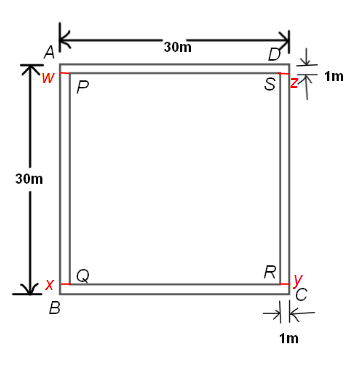
A path $1m$ wide is built inside a square park of side $30m$ along its sides. Find the area of the path. Calculate the cost of constructing the path at the rate of Rs.$70$ per ${m^2}$.
Answer
482.7k+ views
Hint: Here is the problem of mensuration we have. We have to find the area of a particular shape. We are approaching the solution by subtracting the area of small Square from the area of the bigger square (Fig.1). Also here we have to find the cost of constructing the path as the rate is given. To find the cost we will use the unitary method.
Complete step by step answer:

Suppose there are two squares ABCD and PQRS also ABCD is the boundary of the square park and the area between the two squares ABCD and PQRS is the mentioned path in the question. We need to find the area of the path and the cost of constructing the path.
Area of the path = Area of square ABCD - Area of the square PQRS … equation (1)
To find the area of the two squares we need to know the length of the side of both squares.
Length of one side of square ABCD $ = 30m$ [Given]
Length of one side of square PQRS $ = 30 - 1 = 29m$ [ the width of the path is 1m]
We know that the area of the square is $A = {a^2}$ where $A$ stands for the area of the square and $a$ stands for the side of the square. Therefore,
Area of Square ABCD $ = 4 \times {(30)^2} = 4 \times 900 = 3600{m^2}$
Area of Square PQRS $ = 4 \times {(29)^2} = 4 \times 841 = 3364{m^2}$
Now, from equation (1),
Area of the path = Area of square ABCD - Area of the square PQRS
Area of the path$ = 3600 - 3364 = 236{m^2}$
We have to also find the cost of constructing the path at the rate of Rs.$70$per${m^2}$.
Cost of constructing $1{m^2}$path $ = 70Rs.$
$\therefore $ Cost of constructing $236{m^2}$path $ = 236 \times 70 = 16,520Rs.$
Hence the area of the path is $236{m^2}$ and the cost of constructing the path at the rate of Rs.$70$per${m^2}$ is $16520Rs.$
Note:
Second method-
We can also find the area of the path by dividing the shape into rectangles as,
Area of Shape of the path$ = Area(rect.AWZD) + Area(rect.SZRY) + Area(rect.YCBX) + Area(rect.XQPW)$

Complete step by step answer:

Suppose there are two squares ABCD and PQRS also ABCD is the boundary of the square park and the area between the two squares ABCD and PQRS is the mentioned path in the question. We need to find the area of the path and the cost of constructing the path.
Area of the path = Area of square ABCD - Area of the square PQRS … equation (1)
To find the area of the two squares we need to know the length of the side of both squares.
Length of one side of square ABCD $ = 30m$ [Given]
Length of one side of square PQRS $ = 30 - 1 = 29m$ [ the width of the path is 1m]
We know that the area of the square is $A = {a^2}$ where $A$ stands for the area of the square and $a$ stands for the side of the square. Therefore,
Area of Square ABCD $ = 4 \times {(30)^2} = 4 \times 900 = 3600{m^2}$
Area of Square PQRS $ = 4 \times {(29)^2} = 4 \times 841 = 3364{m^2}$
Now, from equation (1),
Area of the path = Area of square ABCD - Area of the square PQRS
Area of the path$ = 3600 - 3364 = 236{m^2}$
We have to also find the cost of constructing the path at the rate of Rs.$70$per${m^2}$.
Cost of constructing $1{m^2}$path $ = 70Rs.$
$\therefore $ Cost of constructing $236{m^2}$path $ = 236 \times 70 = 16,520Rs.$
Hence the area of the path is $236{m^2}$ and the cost of constructing the path at the rate of Rs.$70$per${m^2}$ is $16520Rs.$
Note:
Second method-
We can also find the area of the path by dividing the shape into rectangles as,
Area of Shape of the path$ = Area(rect.AWZD) + Area(rect.SZRY) + Area(rect.YCBX) + Area(rect.XQPW)$

Recently Updated Pages
What percentage of the area in India is covered by class 10 social science CBSE

The area of a 6m wide road outside a garden in all class 10 maths CBSE

What is the electric flux through a cube of side 1 class 10 physics CBSE

If one root of x2 x k 0 maybe the square of the other class 10 maths CBSE

The radius and height of a cylinder are in the ratio class 10 maths CBSE

An almirah is sold for 5400 Rs after allowing a discount class 10 maths CBSE

Trending doubts
The Equation xxx + 2 is Satisfied when x is Equal to Class 10 Maths

Why is there a time difference of about 5 hours between class 10 social science CBSE

Change the following sentences into negative and interrogative class 10 english CBSE

Write a letter to the principal requesting him to grant class 10 english CBSE

Explain the Treaty of Vienna of 1815 class 10 social science CBSE

Write an application to the principal requesting five class 10 english CBSE




